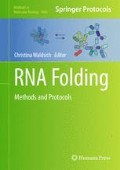Abstract
RNAs have to adopt specific three-dimensional structures to fulfill their biological functions. Therefore exploring RNA structure is of interest to understand RNA-dependent processes. Chemical probing in vitro is a very powerful tool to investigate RNA molecules under a variety of conditions. Among the most frequently used chemical reagents are the nucleobase-specific probes dimethyl sulfate (DMS), 1-cyclohexyl-3-(2-morpholinoethyl) carbodiimide metho-p-toluenesulfonate (CMCT) and β-ethoxy-α-ketobutyraldehyde (kethoxal). These chemical reagents modify nucleotides which are not involved in hydrogen bonding or protected by a ligand, such as proteins or metabolites. Upon performing modification reactions with all three chemicals the accessibility of all four nucleobases can be determined. With this fast and inexpensive method local changes in RNA secondary and tertiary structure, as well as the formation of contacts between RNA and its ligands can be detected independent of the RNA’s length.
Access this chapter
Tax calculation will be finalised at checkout
Purchases are for personal use only
References
Brion P, Westhof E (1997) Hierarchy and dynamics of RNA folding. Annu Rev Biophys Biomol Struct 26:113–137
Pyle AM, Fedorova O, Waldsich C (2007) Folding of group II introns: a model system for large, multidomain RNAs? Trends Biochem Sci 32:138–145
Schroeder R, Barta A, Semrad K (2004) Strategies for RNA folding and assembly. Nat Rev Mol Cell Biol 5:908–919
Sosnick TR, Pan T (2003) RNA folding: models and perspectives. Curr Opin Struct Biol 13:309–316
Treiber DK, Williamson JR (1999) Exposing the kinetic traps in RNA folding. Curr Opin Struct Biol 9:339–345
Treiber DK, Williamson JR (2001) Beyond kinetic traps in RNA folding. Curr Opin Struct Biol 11:309–314
Woodson SA (2000) Compact but disordered states of RNA. Nat Struct Biol 7:349–352
Woodson SA (2005) Structure and assembly of group I introns. Curr Opin Struct Biol 15:324–330
Woodson SA (2010) Compact intermediates in RNA folding. Annu Rev Biophys 39:61–77
Brunel C, Romby P (2000) Probing RNA structure and RNA-ligand complexes with chemical probes. Methods Enzymol 318:3–21
Shcherbakova I, Mitra S, Beer RH et al (2006) Fast Fenton footprinting: a laboratory-based method for the time-resolved analysis of DNA, RNA and proteins. Nucleic Acids Res 34:e48
Waldsich C (2008) Dissecting RNA folding by nucleotide analog interference mapping (NAIM). Nat Protoc 3:811–823
Wilkinson KA, Merino EJ, Weeks KM (2006) Selective 2′-hydroxyl acylation analyzed by primer extension (SHAPE): quantitative RNA structure analysis at single nucleotide resolution. Nat Protoc 1:1610–1616
Ehresmann C, Baudin F, Mougel M et al (1987) Probing the structure of RNAs in solution. Nucleic Acids Res 15:9109–9128
Moazed D, Stern S, Noller HF (1986) Rapid chemical probing of conformation in 16 S ribosomal RNA and 30 S ribosomal subunits using primer extension. J Mol Biol 187:399–416
Brunel C, Romby P, Westhof E et al (1991) Three-dimensional model of Escherichia coli ribosomal 5S RNA as deduced from structure probing in solution and computer modeling. J Mol Biol 221:293–308
Moazed D, Noller HF (1986) Transfer RNA shields specific nucleotides in 16S ribosomal RNA from attack by chemical probes. Cell 47:985–994
Moazed D, Noller HF (1987) Interaction of antibiotics with functional sites in 16S ribosomal RNA. Nature 327:389–394
Moazed D, Noller HF (1989) Interaction of tRNA with 23S rRNA in the ribosomal A, P, and E sites. Cell 57:585–597
Moazed D, Robertson JM, Noller HF (1988) Interaction of elongation factors EF-G and EF-Tu with a conserved loop in 23S RNA. Nature 334:362–364
Moazed D, Samaha RR, Gualerzi C et al (1995) Specific protection of 16 S rRNA by translational initiation factors. J Mol Biol 248:207–210
Konforti BB, Liu Q, Pyle AM (1998) A map of the binding site for catalytic domain 5 in the core of a group II intron ribozyme. EMBO J 17:7105–7117
Waldsich C, Masquida B, Westhof E et al (2002) Monitoring intermediate folding states of the td group I intron in vivo. EMBO J 21:5281–5291
Das R, Laederach A, Pearlman SM et al (2005) SAFA: semi-automated footprinting analysis software for high-throughput quantification of nucleic acid footprinting experiments. RNA 11:344–354
Acknowledgements
This work was supported by the Austrian Science Foundation FWF [grants Y401 and P23497 to C.W.]. We want to thank Katharina Auer for providing the data shown in Fig. 3.
Author information
Authors and Affiliations
Editor information
Editors and Affiliations
Rights and permissions
Copyright information
© 2014 Springer Science+Business Media, LLC
About this protocol
Cite this protocol
Sachsenmaier, N., Handl, S., Debeljak, F., Waldsich, C. (2014). Mapping RNA Structure In Vitro Using Nucleobase-Specific Probes. In: Waldsich, C. (eds) RNA Folding. Methods in Molecular Biology, vol 1086. Humana Press, Totowa, NJ. https://doi.org/10.1007/978-1-62703-667-2_5
Download citation
DOI: https://doi.org/10.1007/978-1-62703-667-2_5
Published:
Publisher Name: Humana Press, Totowa, NJ
Print ISBN: 978-1-62703-666-5
Online ISBN: 978-1-62703-667-2
eBook Packages: Springer Protocols

